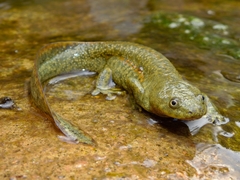Common midwife toad
Alytes obstetricans
Alytes obstetricans, commonly known as the midwife toad or sapo partero in Spanish, is a unique amphibian species found in the Comunidad Valenciana and other parts of Europe. This amphibian is fascinating due to its distinctive reproductive behavior, which involves the male's participation in caring for the offspring.
Here are some key characteristics and behaviors of the Alytes obstetricans:
- Appearance: The midwife toad has a stout body with a grayish to brownish coloration, featuring dark spots that help it blend into its natural surroundings. They typically have a lighter belly.
- Size: These toads are relatively small, with adults reaching between 3.5 and 5.5 centimeters in length.
- Reproduction: The most remarkable feature of the midwife toad is its reproductive strategy. The male carries the fertilized eggs wrapped around his hind legs, protecting and keeping them moist until they are ready to hatch.
- Habitat: Alytes obstetricans is often found in terrestrial habitats, including forests, meadows, and gardens. They favor areas with loose soil for burrowing and proximity to water for breeding purposes.
- Behavior: These toads are mostly nocturnal, spending the day hidden under rocks or in crevices. They are known for their distinctive, melodious calls during the breeding season.
The Alytes obstetricans plays a crucial role in the biodiversity of its habitat. Its unique reproduction strategy and adaptability to different environments make it a fascinating subject of study for both scientists and nature enthusiasts in the Comunidad Valenciana and beyond.







